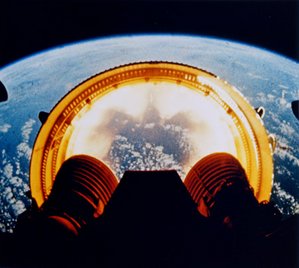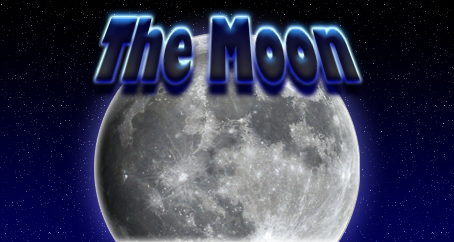The Apollo Missions
Part One - Apollo 1 to Apollo 10
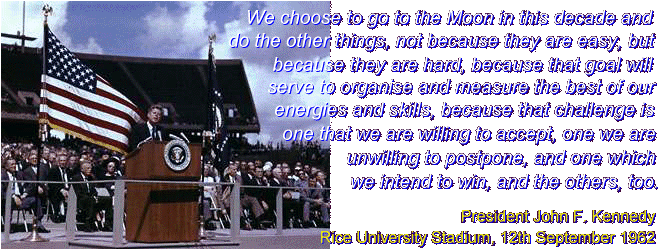
The Apollo missions were planned and developed after American President John F. Kennedy announced in 1962 that he wanted to send a person to the Moon and back by the end of the decade. There were various reasons why President Kennedy said that he wanted to go to the Moon (maybe he wanted a change from Disneyland!). The reason he gave was that it would be a challenge. Landing a person on the Moon would be a massive achievement - a feat of mankind - but it wouldn't be easy. President Kennedy wanted to prove that the people of his country were up for this challenge and that they would achieve it. Secondly, interest in space was at a peak at the time. In the years before Kennedy's speech, satellites had been placed into orbit around Earth and unmanned rockets had been sent to the Moon. Missions were also being planned to send unmanned spacecraft to Venus and Mars. Getting somebody to the Moon seemed to be a natural part of that wave of space exploration. And finally, the third reason, and perhaps the main reason, was that getting to the Moon would prove America's technological supremacy over Russia, or the Soviet Union as it was known at the time.
The start of the Space Race
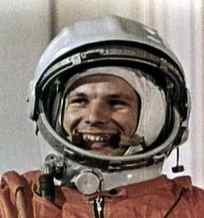
During most of the latter half of the Twentieth Century, America and Russia, the two most powerful countries in the world, had a very hostile relationship. With both countries possessing nuclear weapons, there was a real feeling that if one country pushed the other the wrong way, it could cause a nuclear war on the planet. Despite being allies during World War Two, the two superpowers had differing ideas on how countries should be run, how societies should operate and how the post-war world should be managed. This caused mistrust between the two nations as each tried to outdo the other. Space was one of many areas in which the two nations could compete to prove their might. Unfortunately for America, they were hopelessly losing the Space Race. By the time of John F. Kennedy's speech, Russia had already achieved many space firsts. They actually began the Space Race by launching Sputnik in October 1957, which became the very first manmade object to enter Earth orbit, and the world's first artificial satellite. This sent the fearsome signal to America that the Soviets could launch an attack on the country from space. The Soviet Union continued with their dominance of space with the launch of Sputnik 2 in November 1957, which contained Laika, the first dog in space, followed by Luna 1 in January 1959, the first artificial satellite to orbit the Sun, Luna 2 in September 1959 which was the first manmade object to reach the Moon, Luna 3 in October 1959 which sent back the first images of the far side of the Moon. Yuri Gagarin (pictured left) became the first human being to be put into Earth orbit when Vostok 1 was launched in April 1961. Several attempts by the Soviets to send unmanned craft to Mars and Venus had also already been made and it seemed that it was only a matter of time before they would succeed. By making his announcement in 1962, President Kennedy had decided that enough was enough. America may have been losing the race for space, but by making his announcement, Kennedy placed the finishing line on the Moon. The first country to get there would be the winner of the Space Race. His country now had a goal - to get somebody to the Moon. To make things slightly easier, President Kennedy also pledged a huge amount of money to NASA (something that the Soviet Union lacked!). Although President Kennedy was assassinated in the following year, his successors, President Lyndon Johnson and President Richard Nixon continued with Kennedy's goal to put a man on the Moon.
Apollo became the name of the program that would eventually send a person to the Moon. Before it, there were the Mercury and Gemini programs. These tested manned space travel in Earth orbit but went nowhere near to the Moon, although some of the astronauts involved in the missions would later take part in the Apollo lunar missions. The Apollo missions would begin with several unmanned test flights followed by a few manned flights to the Moon (but not landing on it), and eventually, the actual Moon landings themselves. The method that was used to get somebody to the Moon and back is called Lunar Orbit Rendezvous. And here's a quick explanation of how it works! The Apollo spacecraft was made up of modules, the main ones being the Command Module (CM), sometimes known as the Command Service Module (CSM), and the Lunar Module (LM). The spacecraft would be launched out of Earth's atmosphere using a Saturn V rocket, the world's most powerful rocket. Once launched, the Saturn V rocket would detach from the craft, fall back to Earth and land in the ocean. When out of Earth's atmosphere, the spacecraft would then head towards the Moon on a three day trip. The crew would spend most of this time in the Command Module. Once it had entered orbit around the Moon, two of the three astronauts would enter the Lunar Module. This would detach from the Command Module and descend to the surface of the Moon. The two astronauts in the Lunar Module would leave it, walk around the Moon, plant flags, take pictures, play golf, pick up rocks, and then return to the Lunar Module. The landing platform of the Lunar Module would remain on the Moon as the rest of it, containing the two astronauts, would take off from the Moon and return to the Command Module to dock with it. Once docked, the Lunar Module would again get detached to crash into the surface of the Moon or remain in orbit around it. The Command Module, containing the three astronauts, would return to Earth, protected by a heat shield during re-entry, and land in the ocean to be recovered. Simple!
Apollo 1
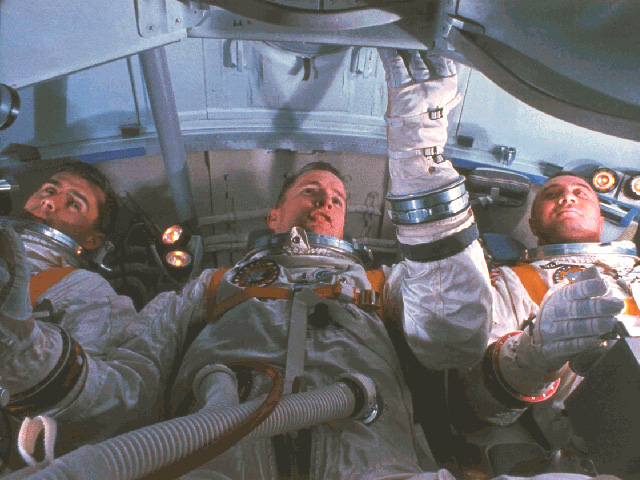
Sadly, the Apollo program began with a tragedy. On 27th January 1967, astronauts Virgil Grissom, Ed White and Roger B. Chaffee (pictured right) were taking part in a training exercise to simulate an actual launch of the Apollo spacecraft. While inside the Command Module on launch pad 34 at the Kennedy Space Center in Florida, a fire broke out. Escape from the Command Module was impossible and the three crew lost their lives within seconds of discovering the fire. The disaster was put down to a fault with the wiring but there were other safety concerns which caused delays to the Apollo program. The failed mission became Apollo 1, named at the request of the widows of the three astronauts involved in the accident. Plaques in honour of the astronauts are on display at launch pad 34 at the Kennedy Space Center and there are craters and hills on the Moon named after the astronauts.
The Unmanned Apollo Missions - Apollo 4, 5 and 6
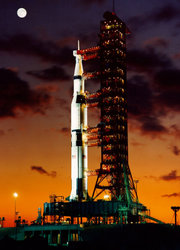
Apollo 4 was the next mission in the program (there was no Apollo 2 or 3), which launched on 9th November 1967. It was an unmanned launch, but tested most of the components which would be used in a normal manned launch. Usually, different components are tested in different missions, but because of the delays caused by the Apollo 1 fire, NASA decided to test them all in one mission. Apollo 4 was the first launch of the Saturn V rocket and the whole mission was extremely successful. Apollo 5 was another unmanned mission, launching on 22nd January 1968. Part of the payload on this mission was the Lunar Module, the part of the spacecraft which would detach from the Command Module and land a man on the Moon. Apollo 6 launched on 4th April 1968, again an unmanned mission. This mission wasn't quite as perfect as Apollo 4, suffering from engine failures. This didn't stop the mission from being aborted, and the spacecraft successfully touched down in the sea and was recovered ten hours after launch. The launch of Apollo 6 was overshadowed because on the same day, Martin Luther King, Jr. was killed.
Getting closer to the Moon - Apollo 7 and 8
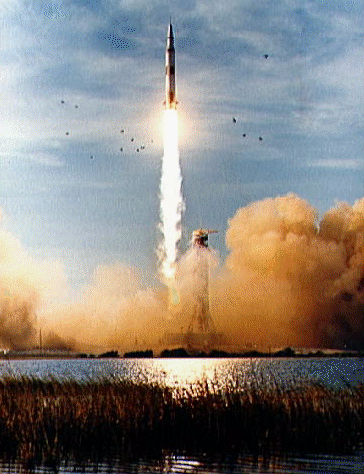
Apollo 7 was the first
manned flight of the Apollo spacecraft, launched on 11th October 1968. Crewed by Wally Shirra, Donn Eisele and Walter Cunningham (the backup
crew for Apollo 1), Apollo 7 was used to test how space-worthy the spacecraft was. It wasn't designed to take the astronauts anywhere near the
Moon, and instead spent 11 days orbiting Earth, completing 163 orbits around the planet. The spacecraft was launched with a Saturn IB rocket,
a smaller and less powerful rocket than a Saturn V. This was because the spacecraft didn't carry a lunar module with it. The first live
television broadcast from an American spacecraft took also took place on Apollo 7. Despite being a successful mission, the crew were not
chosen again for any future mission. This is sometimes believed to be down to their attitude while on Apollo 7. They had to put up with
bad food, they all got a cold and they began talking back to mission control on
Earth!
After the success of Apollo 7, NASA was ready to send a spacecraft to the Moon, although still not quite ready to land anybody
on it. Apollo 8 launched on 21st December 1968, containing astronauts Frank Borman, James Lovell (who would later fly on Apollo 13) and
William Anders. Apollo 8 didn't take a Lunar Module with it, mainly because there wasn't one ready, but NASA still wanted to make Apollo
8 a mission around the Moon because there were rumours that the Soviet Union were getting ready to do the same. NASA launched Apollo 8 with
a dummy Lunar Module and the three astronauts became the first humans to orbit the Moon. Contact with
Earth was lost while the spacecraft
was on the far side of the Moon (the Moon blocked the signal). On Christmas Eve, while in orbit around the Moon, the crew made a television
broadcast to Earth during which they read out a passage from Genesis in the Bible and wished the people on "the good Earth" a Merry Christmas.
Hundreds of photographs were taken of the surface of the Moon, and of Earth from the Moon, including the famous photograph "Earthrise"
(pictured below). Apollo 8 completed 10 orbits of the Moon over 20 hours before setting back for
Earth. The Command Module splashed down on
27th December 1968, 6 days and 3 hours after launching.

The Final Dress Rehearsals - Apollo 9 and 10
Apollo 9 was another manned mission, although unlike Apollo 8, it remained in Earth orbit. It was launched on 3rd March 1969 and was crewed by James McDivitt, David Scott and Russell Schweickart. The mission was used to test the Lunar Module in space since this wasn't available for Apollo 8. Several dockings and undockings took place, including a flight of the Lunar Module which took it 111 miles away from the Command Module. A spacewalk was also completed as a test in case of an emergency which required Extra Vehicular Activity (EVA). Apollo 9 was the first Apollo mission for which the crew were able to give the components of the spacecraft names. They named the Lunar Module "Spider" and the Command Module "Gumdrop". The 10-day mission ended on 13th March 1969 when the craft re-entered Earth's atmosphere and splashed down.
Apollo 10 was the final "test" mission. It was basically a dress rehearsal for a real Moon landing in which everything was done apart from the actual Moon landing itself. Apollo 10 was crewed by Thomas Stafford, John W Young and Eugene Cernan. For this mission, the Lunar Module was named Snoopy and the Command Module was named Charlie Brown. Apollo 10 launched on 18th May 1969 and on 22nd May, while in orbit around the Moon, the Lunar Module, containing Stafford and Cernan, separated from the Command Module. It went as close as 15.6 kilometres from the surface of the Moon, but wasn't equipped to land on it. After redocking with the Command Module on 23rd May, the two Lunar Module astronauts returned to the Command Module and the Lunar Module was detached again and is now the only intact Lunar Module floating about in space (the rest burned up in Earth's atmosphere, crashed into the Moon or remained in Lunar orbit). The Command Module splashed down on 26th May 1969.
The completion of the Apollo 10 mission meant that all the testing had been done to send a man to the Moon, and all in time for the end of the decade as announced by President Kennedy! In just under two more months, Apollo 11 would launch, and a person would walk on the surface of the Moon for the very first time.
Click here for Part Two of the Apollo Missions!
